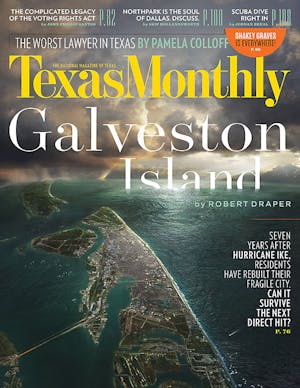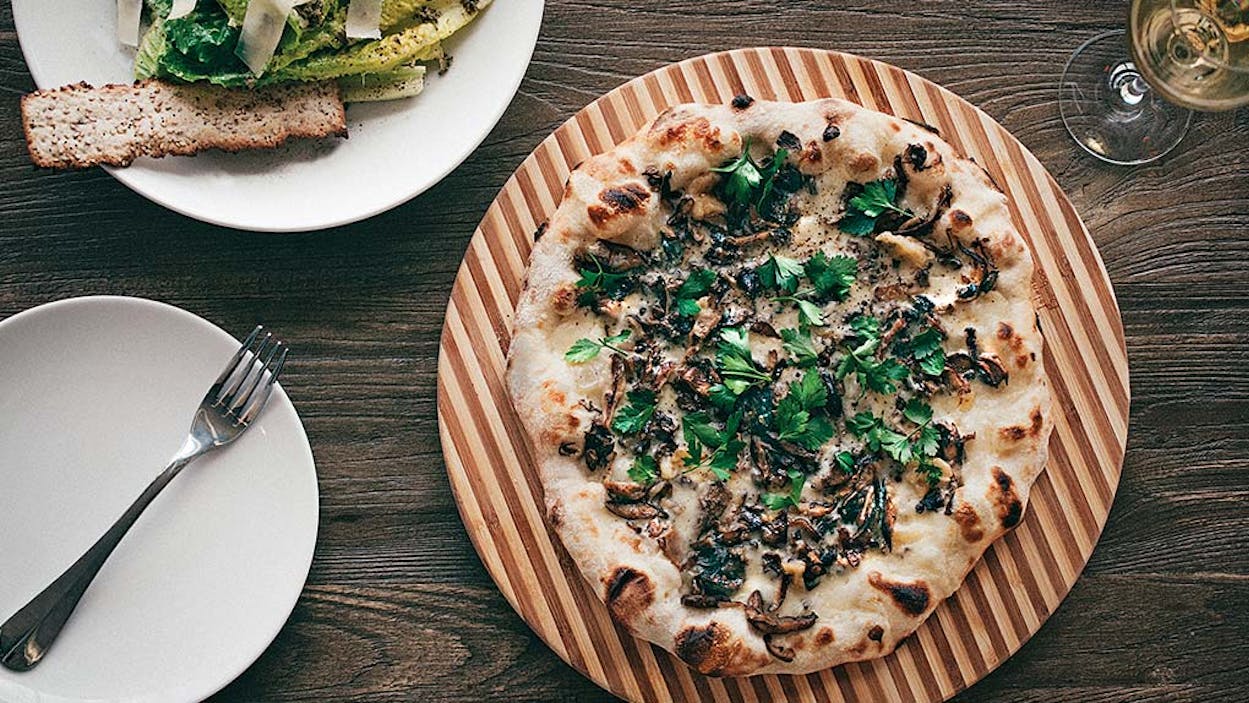It didn’t take me long to see the sights in the miniopolis of Coleman. On a meandering tour of the town of 4,500, a little southeast of Abilene, I cruised past the Shoppin’ Baskit, the county farm bureau, a pawn shop, a family dental center, a plethora of churches, and an even greater plethora of empty buildings. Near the square, I peered through rosebushes to spy on a black-and-white cat asleep on the porch of a once fine old house. Eventually I ended up on the main drag, Commercial Avenue, at one end of which was a bland tan-brick courthouse that had replaced (or, more accurately, swallowed) its predecessor, a stately nineteenth-century building that apparently was considered an affront to modernity back in the fifties, when Coleman was thriving and its population had soared to a whopping 6,500.
But I’m rambling. Toward the other end of Commercial Avenue was the reason I was in town in the first place: Rancho Pizzeria. Until recently, a hungry visitor to Coleman had only a handful of choices: Dairy Queen, Sonic, Subway, Pizza Hut, and local providers of steaks, fried chicken, and the inevitable Chinese food. But the options expanded appreciably at the end of May, when Rancho opened its doors. Now, I understand if you’re wondering how another pizza parlor could improve on the dining possibilities here. But trust me, Rancho is not your godfather’s pizzeria.
You walk into a fifteen-foot-tall room outfitted with maple-wood tables, red bentwood chairs, and booths upholstered in charcoal-gray fabric with nailhead trim. On the left are sculptural metal light fixtures silhouetted against stark white walls. On the right is a wood-fired oven with mesquite and oak logs stacked beneath it. You peruse the menu to find ingredients like shiitake mushrooms, wild arugula, burrata, prosciutto, and soppressata. It’s safe to say that Rancho Pizzeria—owned by Robert and Laurie Williamson, the husband-and-wife team who operate the much-lauded nearby Rancho Loma inn and restaurant (which was featured in our December 2014 cover story on fine dining in small towns)—would stand up to the competition in any Texas city.
I was shown to a table by a shyly smiling waitress. Afraid that I might not be out this way again soon, I ordered as much as I could from the brief menu, which was a work in progress under the creative direction of Laurie, with on-site help from old friend and longtime area chef Joel Trueblood. My first choice proved once again my theory that there’s no such thing as bad tapenade; bright with the flavor of lemon zest, the coarse kalamata olive spread came with grilled bread. There was more toasty bread with the sumptuous burrata and with the goat-cheese-stuffed red piquillo peppers. Thinking that a salad might be a nice counterbalance, I ordered a small Caesar, and indeed the frilly-edged heart-of-romaine leaves were light and crisp, even if the thick anchovy-tinged dressing did derail my scheme.
Although it was hard to decide, I finally settled on two pizzas from the six thin-crusted, puffy-edged varieties offered. The Fungi came lavished with shiitakes, béchamel, and morsels of roasted garlic, all under a melty layer of fontina dabbed with white-truffle oil. Saving most of it to be eaten later, I moved on to a pie topped with Italian sausage, mozzarella, and crushed heirloom tomatoes from the Williamsons’ gardens. Calabrian chiles added a smidge of heat. After a nibble, most of that pizza got stowed away too so I could try the meatballs. Tender, they had a sausage-like richness. When I asked, my server confirmed that they were made with bits of prosciutto, soppressata, and other cured meats as well as ground pork and beef. The day’s desserts were simple and classic—panna cotta, tiramisu, and an affogato, or “espresso float”: a shot of Nespresso lungo coffee poured over vanilla bean ice cream, ideal for someone on the road.
Two weeks later, I was back. Sandwiches had been added to the lunch menu (ham, fontina, and Gruyère; caprese with pesto; meatballs with fontina), and baked pastas and fish were being tried out as occasional offerings. But I really came for the dinner special, a massive Akaushi New York strip. Judiciously crusted in coarse salt and cracked black peppercorns and then seared in a cast-iron skillet inside the wood oven, it was partially sliced and presented on a cutting board, the better to show off its supple, rosy interior.
Over the years, I’ve seen many idealists open promising restaurants in small towns only to find themselves out of touch with local tastes in a place that doesn’t have enough going on to bring in visitors. But this venture—fingers crossed—seems different. The Williamsons aren’t outsiders: they’re both originally from West Texas, and though they moved away and established successful careers in commercial film production, they’ve been back since 2000. And they have been running Rancho Loma long enough to know what guests like.
Perhaps more importantly, they’re in it for the long haul. “About two years ago,” says Robert, “we had an offer to sell, and we spent a month trying to make a decision.” In the end, they turned it down. “We decided to stay and get involved in our community.” With help from the Coleman Community Coalition, they bought a few more buildings and are getting ready to turn one into a coffee shop and another into a gallery. On down the line, plans call for a winery and tasting room across the street (they are planting three acres of grapes on their land at Rancho Loma).
With these pump primers, they hope to encourage like-minded entrepreneurs. “Other businesses are starting up in Coleman since we began this thing,” says Robert. “I think there are ten either open or on the way.” The community is even throwing a block party: the first annual Prickly Pear Festival will be held on October 24, with food and wine, arts and crafts, and live music. Will the ambitious plans take off? Only time will tell. “We’ve been called ‘the green Marfa,’ ” says Robert, referring to another small town in the middle of nowhere. If Marfa beat the odds, maybe Coleman will too.









